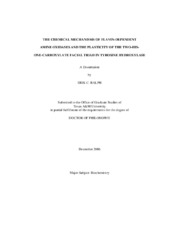| dc.description.abstract | Despite a number of kinetic and spectroscopic studies, the chemical mechanisms
of amine oxidation by flavoenzymes remain widely debated. The mechanisms of by Nmethyltryptophan
oxidase (MTOX) and tryptophan 2-monooxygenase (TMO) were
probed using a combination of pH and primary deuterium, solvent, and 15N kinetic
isotope effects. Slow substrates were chosen for these studies; MTOX was characterized
with N-methylglycine and TMO was characterized with L-alanine. Primary deuterium
kinetic isotope effects of 7.2 and 5.3 were observed for sarcosine oxidation by MTOX
and for alanine oxidation by TMO, respectively, independent of the substrate
concentration and pH. Monitoring the reduction of flavin spectroscopically revealed no
intermediate flavin species with both enzyme-substrate systems. Furthermore, the
magnitudes of the 15N kinetic isotope effects observed with both systems suggest that
nitrogen rehybridization and C-H bond cleavage are concerted. These results are
consistent with both enzymes utilizing a hydride transfer mechanism for amine
oxidation.
The role of the iron ligands of tyrosine hydroxylase (TyrH) was also investigated. TyrH contains one iron per monomer, which is held by three conserved amino acid
residues, two histidines and a glutamate. As a probe of the plasticity of the metal binding
site, each of the metal ligands in TyrH was substituted with glutamine, glutamate, or
histidine. The resulting proteins were characterized for metal content, catalytic activity,
and dopamine binding. The H336E and H336Q enzymes retain substantial catalytic
activity. In contrast, the E376Q enzyme retains about 0.4% of the wild-type catalytic
activity, and the E376H enzyme has no significant activity. The H331E enzyme oxidizes
tetrahydropterin in a tyrosine-independent manner. The position of the charge-transfer
absorbance band for the H336E and H336Q enzyme-inhibitor complexes is shifted
relative to that of the wild-type enzyme, consistent with the change in the metal ligand.
In contrast, the E376H and E376Q enzymes catalyze dopamine oxidation. These results
provide a reference point for further structural studies of TyrH and the other aromatic
amino acid hydroxylases, and for similar studies of other enzymes containing this ironbinding
motif. | en |


